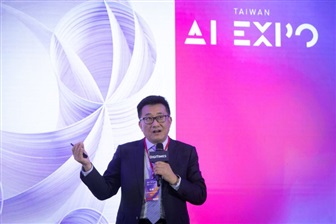Generative AI is entering the corporate application fields and bringing in practical challenges.
Eric Chang, former Partner Director of Technology Strategy at Microsoft Research Asia, pointed out that as AI tools become smarter, businesses need to rethink their resource allocation for technology and manpower. Besides generative AI, progress has also been made in robotics, AI-assisted materials, and pharmaceutical R&D.
On day two of the DIGITIMES AI Expo on April 25, Chang opened the day by asking the audience how many had used tools like ChatGPT. About half of the live audience raised their hands. Among the attendees, more people were excited about AI development than those who were anxious.
Chang believes that the progress of AI can be described using the WYSIWYG framework, progressing from "What You See Is What You Get" at the start to "What You Say Is What You Get," "What You Show Is What You Get," and "What You Seek Is What You Get."
While generative AI applications have experienced explosive growth recently, there have also been many advancements in other fields such as robotics, AI-assisted materials, and pharmaceutical R&D. For example, a team at Stanford University has developed a robot that can fry shrimp in a wok.
Chang observed that Nvidia, in addition to developing AI hardware and software, is also actively involved in biomedical applications, investing nearly US$100 million in the pharmaceutical sector in 2023. Nvidia CEO Jensen Huang has mentioned that more than ten years ago, computer science was a popular field, but Nvidia has continuously lowered the threshold for computational technology, to a point where students should consider life sciences when choosing their university majors.

Photo: Senior associate manager at Nvidia Eric Kang.
Credit: DIGITIMES
Nvidia senior associate manager Eric Kang pointed out that discussions about the current key issues of generative AI are different than the issues discussed a year ago.
Kang stated that while there are now more choices for LLMs, models often need further fine-tuning and optimization when it comes to corporate applications. The Nvidia NeMo platform provides many development and security tools. It recently launched NIM microservices that can speed up deployment and Blackwell GPUs with higher computing performance.
Pre-sales engineering leader of IBM Technology Group in Greater China Jerry Zhu observed that many corporations feel anxiety about the AI boom. Challenges on the application side include a lack of key scenarios, doubts about the output results, difficulty balancing benefits/privacy/data security, and challenges in talent and organizational reshaping.
He emphasized that how corporations test, evaluate, control, and optimize AI systems, as well as building interpretable AI, are significant challenges. Many companies put their best talents in the "testing" section because testing work is crucial for quality control.
IBM suggests that corporations should address AI challenges in four directions: finding key scenarios that align with their strategy, securely and effectively accessing data, a responsible and comprehensive process, and planning talent/organizational transformation.

Photo: Pre-sales engineering leader of IBM Technology Group in Greater China Jerry Zhu.
Credit: DIGITIMES



